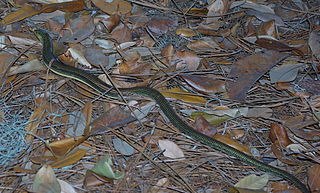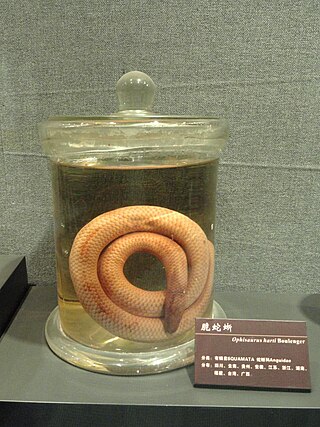This article needs additional citations for verification .(February 2024) |
Fifteen species of reptiles are native within the U.S. state of Arkansas , in the south-central United States.
This article needs additional citations for verification .(February 2024) |
Fifteen species of reptiles are native within the U.S. state of Arkansas , in the south-central United States.
Twelve species of lizard are native to the state. The most common lizards are skinks, with six native Scincidae species. [1]
The Western Slender Glass Lizard ( Ophisaurus attenuatus attenuatus) is also native to the state. [2]

Anguidae refers to a large and diverse family of lizards native to the Northern Hemisphere. Common characteristics of this group include a reduced supratemporal arch, striations on the medial faces of tooth crowns, osteoderms, and a lateral fold in the skin of most taxa. The group is divided into two living subfamilies, the legless Anguinae, which contains slow worms and glass lizards, among others, found across the Northern Hemisphere, and Gerrhonotinae, which contains the alligator lizards, native to North and Central America. The family Diploglossidae was also formerly included. The family contains about 87 species in 8 genera.

Phrynosoma, whose members are known as the horned lizards, horny toads, or horntoads, is a genus of North American lizards and the type genus of the family Phrynosomatidae. Their common names refer directly to their horns or to their flattened, rounded bodies, and blunt snouts.

Urosaurus is a genus of lizards, commonly known as tree lizards or brush lizards, belonging to the New World family Phrynosomatidae. They are native to North America, specifically the arid and semiarid regions of the western United States and Mexico, spending most of their time on trees, shrubs, or boulders.

Ophisaurus is a genus of superficially snake-like legless lizards in the subfamily Anguinae. Known as joint snakes, glass snakes, or glass lizards, they are so-named because their tails are easily broken; like many lizards, they have the ability to deter predation by dropping off part of the tail, which can break into several pieces, like glass. The tail remains mobile, distracting the predator, while the lizard becomes motionless, allowing eventual escape. This serious loss of body mass requires a considerable effort to replace, and can take years to do so. Despite this ability, the new tail is usually smaller than the original.

The slender glass lizard is a legless lizard in the glass lizard subfamily (Anguinae). The species is endemic to the United States. Two subspecies are recognized. The lizard was originally believed to be a subspecies of the eastern glass lizard. Their name comes from their easily broken tail which they can break off themselves without ever being touched. It is difficult to find a specimen with an undamaged tail. The lizard eats a variety of insects and small animals, including smaller lizards. Snakes and other animals are known to prey on the species. Humans have a part in destroying their environment and killing their food supply with insecticides. The lizard is considered to be a least-concern species according to the International Union for Conservation of Nature (IUCN), though it is vulnerable in Iowa and endangered in Wisconsin. It is important to note that the streamlined, legless species is often confused with snakes. Glass Lizards, however, differ from snakes as they possess a moveable eyelid, which is absent in snakes. Another way to distinguish glass lizards from snakes is the presence of an external ear opening, which are absent in snakes.

The sheltopusik, also commonly called Pallas's glass lizard, the European legless lizard, or the European glass lizard, is a species of large glass lizard found from Southern Europe to Central Asia.

The Texas horned lizard is one of about 21 North American species of spikey-bodied reptiles called horned lizards, all belonging the genus Phrynosoma. It occurs in south-central regions of the US and northeastern Mexico, as well as several isolated introduced records and populations from Southern United States. Though some populations are stable, severe population declines have occurred in many areas of Texas and Oklahoma. The Texas spiny lizard may be confused for a Texas horned lizard due to its appearance and overlapping habitat.

The flat-tail horned lizard is a species of lizard in the family Phrynosomatidae. A species of reptile, it is endemic to the Sonoran desert of the southwestern United States and northwestern Mexico. Its multiple adaptations for camouflage help to minimize its shadow. The species is threatened, with a restricted range under pressure from human activities such as agriculture and development, and is specially protected in the United States.

The six-lined racerunner is a species of lizard native to the United States and Mexico.

The California slender salamander is a lungless salamander that is found primarily in coastal mountain areas of Northern California, United States as well as in a limited part of the western foothills of the Sierra Nevada, California, in patches of the northern Central Valley of California, and in extreme southwestern Oregon. This species resides primarily in a limited range within California as one of a handful quasi-endemic amphibians in the state.

Koelliker's glass lizard, also called commonly the Moroccan glass lizard, is a species of lizard in the family Anguidae. The species is native to western North Africa.

The eastern glass lizard is a species of legless lizard in the family Anguidae, endemic to the Southeastern United States. The streamlined, legless species is often confused with snakes. Glass lizards differ from snakes as they possess a moveable eyelid and an external ear opening, both of which are absent in snakes. Ventralis comes from the Latin "venter" meaning belly; this is in reference to the snake-like movement.

The mimic glass lizard is a species of lizard in the family Anguidae. The species is endemic to the Southeastern United States. The mimic glass lizard is dark brown to black with a dark middorsal stripe down the body and on most of the tail. They have 3-4 dark stripes separated by pale stripes above the lateral grooves. They have a very distinct anatomy of the axis specifically when it comes to their second vertebra which could be attributed to an ecological adaptation, feeding, and/or defensive behavior that requires high head and neck mobility.

Dopasia is a genus of lizards in the family Anguidae. The genus contains seven species, which are native to Asia. They are most closely related to the North American Ophisaurus, and are sometimes considered part of that genus.

Dopasia harti, also known commonly as the Chinese glass lizard and Hart's glass lizard, is a species of lizard in the family Anguidae. The species is native to southeastern Asia.